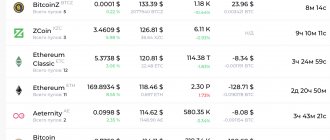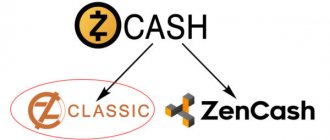In early 2009, a mysterious cryptocurrency developer (or team of developers) working under the pseudonym Satoshi Nakamoto released the first program that implemented Bitcoin as a digital currency. Since then, Bitcoin has not only gained widespread popularity around the world, but has also inspired hundreds of other digital currencies.
Many of these cryptocurrencies use aspects that were already inherent in Bitcoin and the Satoshi concept. Others are taking the Bitcoin model and adapting or trying to improve on it. In some cases, Bitcoin has spawned coins that are based on the same basic concept and software but are different from the original.
In these situations, the Bitcoin blockchain has undergone a process known as a fork, whereby the blockchain itself is split into two separate entities.
It was thanks to forks that various digital currencies with names similar to Bitcoin began to appear: Bitcoin Cash, Bitcoin Gold and others.
For an investor new to cryptocurrency, it can be difficult to tell the difference between these cryptocurrencies and compare the various forks on a timeline.
The table below contains information about all Bitcoin forks, and we will look at successful and popular ones further in the article .
| Name | date | Block | Ratio | Status |
| Bitcoin Cash (BCH) | August 1, 2017 | 478558 | 1:1 | Active |
| Bitcoin Gold (BTG) | October 24, 2017 | 491407 | 1:1 | Active |
| Bitcoin Diamond (BCD) | November 24, 2017 | 495866 | 1:10 | Active |
| UnitedBitcoin (UBTC) | December 12, 2017 | 498777 | 1:1 | Semi-active* |
| Bitcoin Hot (BTH) | December 12, 2017 | 498848 | 1:100 | Semi-active* |
| Super Bitcoin (SBTC) | December 12, 2017 | 498888 | 1:1 | Semi-active* |
| BitcoinX (BCX) | December 12, 2017 | 498888 | 1:10000 | Semi-active* |
| Oil Bitcoin (OBTC) | December 12, 2017 | 498888 | 1:1 | Dead |
| ABitcoin (ABTC) | December 12, 2017 | 498888 | 1:100 | Dead |
| Bitcoin World (BTW) | December 17, 2017 | 499777 | 1:10000 | Dead |
| Lightning Bitcoin (LBTC) | December 19, 2017 | 499999 | 1:1 | Active |
| Bitcoin Stake (BTCS) | December 19, 2017 | 499999 | 1:100 | Dead |
| BitEthereum (BITE) | December 21, 2017 | — | 1:3.94 | Dead |
| Bitcoin Top (BTT) | December 26, 2017 | 501118 | 1:1 | Dead |
| Bitcoin God (GOD) | December 27, 2017 | 501225 | 1:1 | Semi-active* |
| Bitcoin FILE (BIFI) | December 27, 2017 | 501225 | 1:1 | Semi-active* |
| Bitcoin Cash Plus (BCP) | December 28, 2017 | 501407 | 1:1 | Dead |
| Quantum Bitcoin (QBTC) | December 28, 2017 | — | 1:1 | Dead |
| SegWit2x (B2X) | December 28, 2017 | 501451 | 1:1 | Dead |
| Bitcoin Uranium (BUM) | December 31, 2017 | — | 1:1 | Dead |
| Bitcoin Pizza (BPA) | December 31, 2017 | 501888 | 1:1 | Dead |
| Bitcoin All (BTA) | December 31, 2017 | — | 1:1 | Dead |
| Bitcoin Ore (BCO) | December 31, 2017 | 501949 | 1:1 | Dead |
| Bitcoin Rhodium (BTR) | January 10, 2018 | 501949 | 1:10 | Dead |
| Bitcoin Smart (BCS) | January 19, 2018 | 505050 | 1:100 | Dead |
| Bitcoin Interest (BCI) | January 20, 2018 | 505083 | 1:1 | Almost dead** |
| Bitcoin Lite (BTCL) | January 30, 2018 | — | 1:1 | Almost dead** |
| Bitcoin Atom (BCA) | January 24, 2018 | 505888 | 1:1 | Almost dead** |
| Bitcoin Private (BTCP) | February 28, 2018 | 511346 | 1:1 | Semi-active* |
Semi-active* - average trading volumes, but completely dead GitHub.
Almost dead** - almost no trades and dead GitHub.
Genesis Block
In 2009, shortly after the release of Bitcoin, Satoshi mined the first block in the Bitcoin blockchain. This is called the "Genesis block" as it represented the beginning of cryptocurrency as we know it today.
Satoshi was able to make numerous changes to the Bitcoin network early in the process. This is becoming increasingly difficult, and Bitcoin's user base has grown significantly.
The fact that no one person or group can determine when or how Bitcoin should be updated has also complicated the process of updating the system. hard forks in the years following the Genesis block .
During a hard fork, the software that implements Bitcoin and its mining procedures is updated. Once a user updates their software, that version rejects all transactions from the older software, effectively creating a new branch of the blockchain.
However, those users who retain the old software continue to process transactions, meaning that there is a parallel set of transactions going through two different chains.
Bitcoin XT
Bitcoin XT was one of the first known hard forks of Bitcoin. The software was launched by Mike Hearn in late 2014 to include several new features he had proposed.
While the previous version of Bitcoin allowed up to seven transactions per second, Bitcoin XT was designed for 24 transactions per second. To achieve this, it was proposed to increase the block size from 1 megabyte to 8 megabytes.
Bitcoin XT was initially successful, with its software running on over 1,000 nodes in late summer 2015.
However, just a few months later, the project lost user interest and was effectively left dead. Bitcoin XT is technically still available, but it has actually fallen out of favor.
What are the types of forks?
Forks are divided into “ soft” or soft forks ; they do not lead to the creation of a new blockchain, but only add features to the work of an existing one. And “ heavy” or hard forks , as a result of which a new blockchain network is formed, which in many ways, however, continues the “traditions” of the old one.
- Soft forks are usually carried out by cryptocurrency developers or large mining pools. To carry out such an operation, it is necessary to enlist the support of the majority of community members, coordinately roll back the network several blocks back and make the appropriate changes. Segwit protocol was created in 2020 , the function of which was to move part of the data processed by the blockchain outside of it.
- A hard fork or hard fork involves changes that are “incomparable to the life” of the old blockchain, so the created new blockchain can no longer interact with the old one, and transactions performed earlier are not recognized by the new network. The most striking example is the Bitcoin Cash , the main innovation of which was an increase in the block size from 1 to 8 megabytes.
It is hard forks that create new cryptocurrencies.
Bitcoin Classic
When Bitcoin XT began to die, some members of the community still wanted modernization and an increase in block sizes.
In response, a group of developers launched Bitcoin Classic in early 2020.
Unlike XT, which proposed increasing the block size to 8 megabytes, Classic only intended to increase it to 2 megabytes. Like Bitcoin XT, initial interest in Bitcoin Classic attracted approximately 2,000 nodes over several months during 2016.
The project also exists today, with some developers actively supporting Bitcoin Classic. However, the broader cryptocurrency community appears to have generally moved on to other options.
Litecoin (LTC)
Litecoin
Litecoin was the second fork of Bitcoin after Namecoin, launched in 2011. However, unlike the latter, some key technologies were changed in it. The creator of the coin is Charlie Lee, a well-known public crypto personality. Like Bitcoin, the Litecoin cryptocurrency aims to take a leading place as a means of payment.
The developers slightly changed and improved the Bitcoin source code:
- The encryption algorithm was replaced from SHA-256 to Scrypt, due to which at first Litecoin was “ASIC-resistant”;
- The emission has been increased fourfold (84 million LTC versus 21 million BTC);
- The block generation time has been reduced to 2.5 minutes, while the network is capable of processing 56 transactions per second.
Also in 2020, the Lightning Network protocol was integrated, making transactions very cheap. Later, SegWit technology was added, as well as atomic swaps with three cryptocurrencies at once (Decred, Vertcoin and Bitcoin).
Until 2013, the cryptocurrency remained unknown, but then it showed a phenomenal 20-fold growth and confirmed its nickname “digital silver.” At the time of writing, Litecoin is ranked 6th in the CoinMarketCap rankings, and its price is slightly above $90.
Bitcoin Cash
In response to SegWit, some Bitcoin developers and users decided to initiate a hard fork to avoid protocol updates.
Bitcoin Cash was the result of this hard fork. It forked from the main blockchain in August 2020.
Bitcoin Cash remains the most successful hard fork of the primary cryptocurrency. As of this writing, it is the fifth largest digital currency by market capitalization, thanks in part to the support of many prominent figures in the cryptocurrency community and many popular exchanges.
Bitcoin Cash allows 8 megabyte blocks and does not use the SegWit protocol.
SegWit2x: unnecessary hard fork?
The SegWit2x hard fork , scheduled for November 16, has caused a lot of publicity. Participants in the cryptocurrency market are divided into two camps. "Pros and cons". Moreover, those who are against the launch of SegWit2x do not intend to work with the new Bitcoin at all, and they have good reason. This will be the third Bitcoin fork. Articles about the previous split have already been published; we will only briefly touch on previous topics so as not to repeat ourselves.
New York Agreement (NYA)
On May 20-21, 2020, a meeting of miners and heads of cryptocurrency companies was held. The result of this meeting was an agreement on two points:
a) the launch of the Segregated Witness protocol with the support of miners with at least 80% of the network hashrate;
b) about updating the software to increase the block size to 2 MB.
In total, the agreement was signed by 56 companies and supported by miners with 83% of the computing power.
The results of the New York meeting caused a lot of controversy for a number of reasons. First of all, in percentage terms, the number of signatories was disproportionately smaller than the total number of developers and market participants. Further, the hard fork itself was not such a necessary measure, and since it divided market participants into two opposing sides, the future of the new cryptocurrency may be very vague. Not surprisingly, the number of companies signing the agreement had declined over time by November. Among the signatories were the Chilean exchange SurBTC, the Argentine credit company Wayniloans, the Chinese pool F2Pool, the German payment service Bitwala, the American company Yours and some others. In total, the upcoming hard fork currently has the support of 41 participants in the New York Agreement, including such large players as BTCC, Bitfury, Bitmain, Blockchain.info, Coinbase, Genesis Mining, ViaBTC, F2Pool.
Bitcoin Gold
Bitcoin Gold was a hard fork that followed a few months after Bitcoin Cash in October 2020. The creators of this hard fork sought to restore the functionality of mining using GPUs (video cards), since they believed that ASICs lead to .
One of the unique features of Bitcoin Gold was the "Insta-mine", a process in which the development team mined 100,000 coins after the fork took place.
Many of these coins have been placed in a special "fund", and the developers have indicated that this fund will be used to grow and fund the Bitcoin Gold ecosystem, with a portion of these coins also being allocated as development fees.
Generally, Bitcoin Gold adheres to many of the core principles of Bitcoin. However, it differs in terms of the PoW algorithm that is required from miners.
Bitcoin is facing another hard fork in November.
The industry's biggest players, including Bitcoin investor Roger Ver, who has earned the nickname "Bitcoin Jesus" for his efforts to promote the cryptocurrency, say consensus between the opposing camps is looking increasingly unlikely.
This view is supported by some of the largest mining pool operators, as well as programmers known as “core” developers who have played an important role in the development of the Bitcoin network infrastructure. A month and a half ago, as a result of similar disagreements, a new cryptocurrency, Bitcoin Cash, appeared.
Ver has transferred some of his funds into it as he anticipates a second cryptocurrency split in 2020. He admits that he could win by doing this, since the split will result in more coins.
“There will probably be another split between legacy Bitcoin and SegWit2X, but that will just give me more coins that I can sell for Bitcoin Cash,” Ver said in an interview with Bloomberg Television.
The popularity of Bitcoin has led to an increase in transaction times and processing fees. The discussion about a possible solution to this problem has divided the community, with some proposing to increase the number of transactions in each block that must be verified by miners, while others advocate moving some of the information from the main network.
One faction of the community is pushing for a network update in November, and this could lead to a split if consensus is not reached.
After the split in early August that led to the emergence of Bitcoin Cash, Bitcoin initially fell 6.8%, but within a month its price reached an all-time record, briefly exceeding $5,000.
If there is a new split in November, a third version of the cryptocurrency will appear and this could lead to a dispersion of capital and resources. SegWit2x is a compromise proposal designed to solve the problem of exploding transactions. In August, miners agreed to implement the first phase of this proposal, SegWit. It was expected that in the second stage, during November, they would increase the block size to two megabytes.
According to Wang Chong, co-owner and chief administrator of one of the world's largest mining pools, F2Pool, to avoid a split, the second phase of SegWit2x must receive at least 92 percent support from miners, but this is becoming increasingly unlikely.
Although SegWit2x received over 93% support in July, miners and developers now seem to be dropping support for it.
According to Wang Chong, the split will happen “100%.”
Many developers agree with him. Some of them stated that in the future they would prefer to focus on writing code only for the SegWit blockchain.
“Many developers, users, miners and businesses have already stated that they do not agree with the pointless 2x fork, so there will most likely be three chains in the end. In the long term, only a core blockchain that has the support of users and developers can survive,” said Samson Moe, chief strategy officer at Blockstream.
Already, key players are warning investors that they should prepare for more serious difficulties. Core developers, including Peter Todd, say a fork this time could cause more concern and lead to more confusion among users about which version is the real Bitcoin.
“In a sense, a split is 100% guaranteed. It will likely be more disruptive,” said Todd, a key Bitcoin developer.
Bitcoin Private
Bitcoin Private is a fork of Bitcoin and Zclassic designed to improve the privacy and usability of the Bitcoin blockchain while staying on top of the issues, options, and failures of previous forks.
Like Bitcoin, BTCP will support peer-to-peer transactions without intermediaries. These transactions will be verified by network nodes using cryptography and recorded in a public ledger.
Unlike Bitcoin, BTCP supports increased block sizes and block times for faster transactions with lower fees. Additionally, transactions can be performed on an anonymous (z) ledger. When sending from one personal address to another, the sender, recipient and amount are personal.











